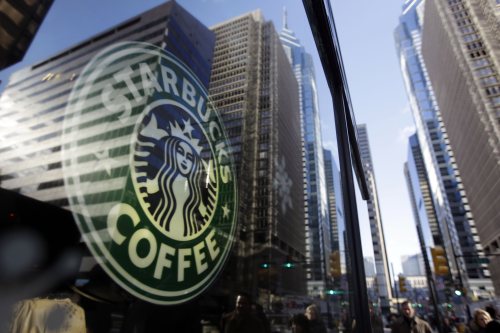NEW DELHI (AFP) ― The familiar green logo of Starbucks will soon appear on Indian streets as the U.S. group bets on lifestyle changes that are turning the tea-drinking country into a booming market for cafes.
India’s appetite for the bitter brew has never been stronger, with its overwhelmingly young population opting to while away time in shiny Western-style cafes instead of the traditional coffeehouses.
Starbucks said earlier this month it will enter India through a tie-up with the country’s biggest coffee producer, Tata Coffee, sourcing beans from south India and roasting them locally. The first store is expected in six months.
Arun Bhardwaj, vice president for emerging business at Starbucks, told AFP by email that it was “premature” to talk specifics about the group’s strategy, but it is expected to adapt its menu to local tastebuds.
U.S. chains Pizza Hut and McDonald’s have “Indianized” their offerings, selling Indian cottage cheese pizzas and spicy potato burgers to woo subcontinental consumers.
India’s appetite for the bitter brew has never been stronger, with its overwhelmingly young population opting to while away time in shiny Western-style cafes instead of the traditional coffeehouses.
Starbucks said earlier this month it will enter India through a tie-up with the country’s biggest coffee producer, Tata Coffee, sourcing beans from south India and roasting them locally. The first store is expected in six months.
Arun Bhardwaj, vice president for emerging business at Starbucks, told AFP by email that it was “premature” to talk specifics about the group’s strategy, but it is expected to adapt its menu to local tastebuds.
U.S. chains Pizza Hut and McDonald’s have “Indianized” their offerings, selling Indian cottage cheese pizzas and spicy potato burgers to woo subcontinental consumers.

Despite its reputation for tea, India has a long-standing coffee-drinking tradition, particularly in the southern state of Tamil Nadu where it is often brewed overnight, then mixed with milk and sugar before being served.
But old-school cafes like the 53-year-old Indian Coffee House chain, which popularized south Indian filter coffee, are now struggling to make a profit while hipper, Western-style chains are opening outlets every month.
A South Indian filter coffee typically costs as little as 10 rupees (about 22 US cents) at small restaurants, but increasingly affluent Indians in urban areas are choosing to sip on cappuccinos costing up to 75 rupees instead.
The change in tastes has less to do with a fondness for Italian espresso, say analysts, and more to do with the social cachet conferred by the beverage in class-conscious India, analysts say.
Harish Bijoor, a brand specialist with expertise in coffee told AFP, “unlike tea, coffee ― particularly espresso-based coffee ― isn’t easy to make. It takes a lot more preparation, so there’s an aura of sophistication around it.”
But the US coffee giant is far from the first to see the potential in the growing affluence of India’s young population.
In addition to the Indian-owned Cafe Coffee Day chain which leads the pack with more than 1,000 outlets, foreign-owned chains Barista Lavazza and Costa Coffee are already present and plan to open more stores.
Vijay Chugh, vice-president of Mumbai’s Ambit Capital brokerage, said Starbucks would “have to ramp up fast” and open several outlets by 2012 because their competition has a headstart in India.
British-based Costa Coffee’s international marketing head Mita Padhi told AFP she was “not worried” by the prospect of new competition as “we already compete with Starbucks in many markets.”
India’s coffee market has enough space for a slew of brands, according to Cafe Coffee Day’s head of marketing K. Ramakrishnan.
“Only 22 percent of urban youth are going to cafes now so there’s lots of room for growth,” he said.
Brand specialist Bijoor agreed.
“The Indian market can house about 5,400 cafes. Currently less than one-third of those cafes exist so there’s plenty of opportunity for Starbucks and other chains,” he told AFP.
But despite all the growth in the domestic coffee market, Indians remain overwhelmingly tea drinkers.
They consumed around 700,000 tons of tea grown in the country last year compared with 75,000 tons of coffee, according to the Tea Board and Coffee Board of India.







![[KH Explains] How should Korea adjust its trade defenses against Chinese EVs?](http://res.heraldm.com/phpwas/restmb_idxmake.php?idx=644&simg=/content/image/2024/04/15/20240415050562_0.jpg&u=20240415144419)










![[Today’s K-pop] Stray Kids to return soon: report](http://res.heraldm.com/phpwas/restmb_idxmake.php?idx=642&simg=/content/image/2024/04/16/20240416050713_0.jpg&u=)